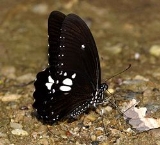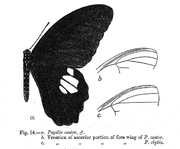
Papilio castor
Encyclopedia
The Common Raven is a species of swallowtail
butterfly found in South Asia
.
Male has the upper wings black, more or less irrorated with yellowish-brown scales that form on the fore wing somewhat indistinct longitudinal cell-lines and internervular streaks. The hind wing has an upper discal cream-coloured patch composed of an oval spot in interspace 4, a more elongate mark broadened outwardly in interspace 5, a similar elongate mark in interspace 6, and a much smaller broadly oval spot above it in 7; these markings not coalescent but distinctly divided by the black veins. cilia on fore and hind wings black alternated with white.
Underside of the male is duller, and more opaque than on the upperside; the brownish-black apical area of fore and base of hind wing thinly sprinkled with yellowish-brown scales. The underside of the fore wings has a small white spot on middle discocellular and a subterminal and terminal row of small white specks that do not extend to the costa. Hind wing markings are similar to those on the upperside but smaller, more widely divided one from the other by the veins which are edged with black; a subterminal more or less well-defined series of small white lunules and a terminal series of white specks. Antenna, head, thorax and abdomen black; on the underside of the body a spot behind the eyes and white spots and specks on the thorax and abdomen.
The female has the upperside a duller more opaque black than in the male but more densely irrorated with yellowish or reddish-brown scales. The fore wing markings are as in the male, with in addition postdiscal and terminal series of small white spots that generally do not extend to the costal margin. The hind wing has a discal series of diffuse broad whitish streaks in the interspaces that extend into the apex of the cell, followed by a complete transverve curved subterminal series of white lunules; the groundcolour beyond each lunule devoid of the irroration of yellowish-brown scales; this gives the appearance of a row of terminal black spots impressed on the wing. Cilia black alternated with white. Underside similar, the white markings larger and more prominent. Fore wing: diffuse whitish streaksin interspaces la, 1 and 2, and the subterminal and terminal series of white spots complete. Hind wing with diffuse whitish streaks that extend up to the base of the wing. Antennae black; head, thorax and abdomen dull brown spotted with white.
 The female is similar to the male, but on the upperside, it has a subterminal series of white spots on the forewing, sometimes with the anterior ones enlarged, sometimes with the series incomplete. Hind wing is as in the male.
The female is similar to the male, but on the upperside, it has a subterminal series of white spots on the forewing, sometimes with the anterior ones enlarged, sometimes with the series incomplete. Hind wing is as in the male.
Swallowtail butterfly
Swallowtail butterflies are large, colorful butterflies that form the family Papilionidae. There are over 550 species, and though the majority are tropical, members of the family are found on all continents except Antarctica...
butterfly found in South Asia
South Asia
South Asia, also known as Southern Asia, is the southern region of the Asian continent, which comprises the sub-Himalayan countries and, for some authorities , also includes the adjoining countries to the west and the east...
.
Description
- See glossaryGlossary of Lepidopteran termsThis glossary describes the terms used in the formal descriptions of insect species, jargon used mostly by professionals or entomologist....
for terms used
Male has the upper wings black, more or less irrorated with yellowish-brown scales that form on the fore wing somewhat indistinct longitudinal cell-lines and internervular streaks. The hind wing has an upper discal cream-coloured patch composed of an oval spot in interspace 4, a more elongate mark broadened outwardly in interspace 5, a similar elongate mark in interspace 6, and a much smaller broadly oval spot above it in 7; these markings not coalescent but distinctly divided by the black veins. cilia on fore and hind wings black alternated with white.
Underside of the male is duller, and more opaque than on the upperside; the brownish-black apical area of fore and base of hind wing thinly sprinkled with yellowish-brown scales. The underside of the fore wings has a small white spot on middle discocellular and a subterminal and terminal row of small white specks that do not extend to the costa. Hind wing markings are similar to those on the upperside but smaller, more widely divided one from the other by the veins which are edged with black; a subterminal more or less well-defined series of small white lunules and a terminal series of white specks. Antenna, head, thorax and abdomen black; on the underside of the body a spot behind the eyes and white spots and specks on the thorax and abdomen.
The female has the upperside a duller more opaque black than in the male but more densely irrorated with yellowish or reddish-brown scales. The fore wing markings are as in the male, with in addition postdiscal and terminal series of small white spots that generally do not extend to the costal margin. The hind wing has a discal series of diffuse broad whitish streaks in the interspaces that extend into the apex of the cell, followed by a complete transverve curved subterminal series of white lunules; the groundcolour beyond each lunule devoid of the irroration of yellowish-brown scales; this gives the appearance of a row of terminal black spots impressed on the wing. Cilia black alternated with white. Underside similar, the white markings larger and more prominent. Fore wing: diffuse whitish streaksin interspaces la, 1 and 2, and the subterminal and terminal series of white spots complete. Hind wing with diffuse whitish streaks that extend up to the base of the wing. Antennae black; head, thorax and abdomen dull brown spotted with white.
Race mehala, Grose-Smith
The male has the upperside velvety dark brown; there is a minute white spot on the middle discocellular and a series of terminal white specks in each interspace. The hind wing has a discal series of seven elongate, more or less inwardly conical, outwardly emarginate cream-coloured spots, followed by a subterminal series of lunular small white spots. Cilia black, alternated with white in the interspaces. Underside brownish-black, markings similar. Fore wing with the terminal series of white specks elongated inwards. Hind wing: the markings somewhat larger. Antenna, head, thorax and abdomen brownish black; head, thorax and abdomen speckled with white.
Other reading
- Collins, N.M. & Morris, M.G. (1985) Threatened Swallowtail Butterflies of the World. IUCN. ISBN 978-2-88032-603-6
- Evans, W.H. (1932) The Identification of Indian Butterflies. (2nd Ed), Bombay Natural History Society, Mumbai, India
- Haribal, Meena (1994) Butterflies of Sikkim Himalaya and their Natural History.
- Wynter-Blyth, M.A. (1957) Butterflies of the Indian Region, Bombay Natural History Society, Mumbai, India.

